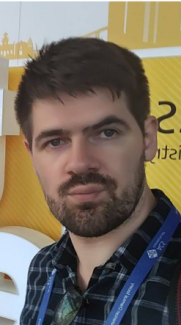Event
Physical Chemistry Seminar, Dr. Alexey Akimov, University of Buffalo
Inquiries please contact Rosa M. Vargas rvargas@sas.upenn.edu

"Nonadiabatic Dynamics for Solar Energy Materials: Assessment, Advancement, and Applications"
- Dynamics of excited states plays a determining role in many materials including photovoltaic solar energy harvesters, photocatalysts, or photo-actuated molecular switches. Electron-hole recombination, interfacial charge transfer, nonradiative excitation energy relaxation, photoinduced nuclear reorganization, and bond breaking - all require going beyond the familiar Born-Oppenheimer approximation and accounting for nonadiabatic (NA) effects. The computational modeling of nonadiabatic and quantum dynamics (NA/QD) at the atomistic level can provide valuable insights into mechanisms of charge and excitation energy transfer in solar energy harvesting materials and suggest potential routes for improving their efficiencies. At the same time, such modeling is challenging due to its demanding computational complexity and its reliance on various underlying approximations. On one hand, one needs to extend the systems’ size and processes’ time scales accessible to direct modeling. On the other hand, one needs to know how the approximations used can affect the predicted “observables” extracted from the NA/QD calculations.
In this presentation, I will overview several approaches we have developed to address some of the above challenges. In particular, as they apply to the so-called trajectory surface hopping calculations. In the “Assessment” part, I will discuss the sensitivity of NA/QD calculations to the choice of electronic structure methodology and decoherence corrections schemes. Such effects will be exemplified with the help of abstract models and atomistic systems such as molecular clusters and organic heterojunctions. The implications, diagnostics, and possible corrections will be discussed. In the “Advancement” part, I will share with you some ideas on handling larger systems and longer dynamics. In particular, I will discuss the use of Landau-Zener-inspired approach to model hot carrier relaxation dynamics in nanoscale silicon clusters and our machine-learning-inspired quasi-stochastic Hamiltonian approach to enable modeling of nanosecond-long NA/QD in atomistic systems at a negligible computational cost. The “Application” part will be interspersed among the previous two. I will discuss the qualitative trends in the non-radiative relaxation rates of hot charge carriers in silicon nanoclusters and their relation to surface termination, types of nuclear motion, and nanoparticle sizes. Another example will highlight the interfacial charge transfer dynamics in organic heterojunctions and the role of decoherence, molecular and orbital symmetries in determining the nonadiabatic population transfer rates.
Bio: Alexey V. Akimov was born in Bryansk oblast, Russia. He received his Diploma in Chemistry in 2007 from Chemistry Department of the M. V. Lomonosov Moscow State University, Moscow, Russia, under joint supervision of Prof. Alexander Nemukhin (MSU, Russia) and Prof. Anatoly Kolomeisky (Rice University, U.S.A.). He obtained his Ph.D. in Chemistry under Prof. Anatoly Kolomeisky from Rice University, Department of Chemistry and Biochemistry in 2011. In the period of 2012-2014 he worked as a postdoctoral researcher in a joint program between the University of Rochester (Oleg Prezhdo group) and the Brookhaven National Laboratory, Department of Chemistry (James Muckerman group). In 2014 he moved to the University of Southern California, Chemistry Department together with the Prezhdo group. In 2015 he joined the Chemistry Department at UB, SUNY as an Assistant Professor.
Dr. Akimov's research interests include the development, implementation, and systematic assessment of semiclassical and quantum-classical methodologies for accurate and efficient simulation of nonadiabatic and quantum dynamics. His group aims to enable the use of advanced dynamical methodologies in studies of photoinduced processes of charge and energy transfer in solar energy materials and functional nanomaterials.
References:
[1] Smith, B.; Akimov, A. V. "A comparative analysis of surface hopping acceptance and decoherence algorithms within the neglect of back-reaction approximation" J. Chem. Phys. 2019 151, 124107
[2] Sato, K.; Pradhan, E.; Asahi, R.; Akimov, A. V. "Charge transfer dynamics at the boron subphthalocyanine chloride/C60 interface: non-adiabatic dynamics study with Libra-X" Phys. Chem. Chem. Phys. 2018 20, 25275-25294
[3] Akimov, A. V.; "Stochastic and Quasi-Stochastic Hamiltonians for Long-Time Nonadiabatic Molecular Dynamics" J. Phys. Chem. Lett. 2017 8, 5190-5195
[4] Lin, Y.; Akimov, A. V. "Dependence of Nonadiabatic Couplings with Kohn–Sham Orbitals on the Choice of Density Functional: Pure vs Hybrid" J. Phys. Chem. A. 2016 120, 9028-9041
